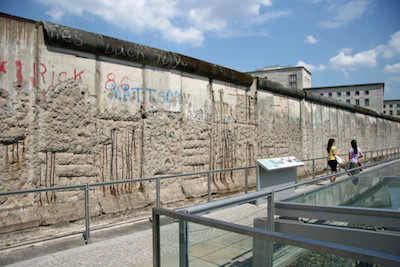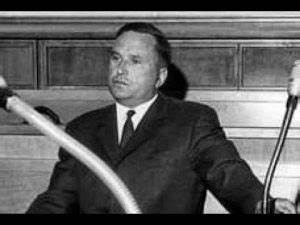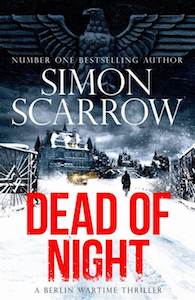DEAD OF NIGHT is the sequel to BLACKOUT, the first two books in series of crime novels set against the backdrop of Berlin during the Second World War.
One of my key convictions as an historical novelist is that it is important to travel to where a novel is set to get some sense of the atmosphere and the feel of a place. So I packed my bags for the first of my research trips to the German capital and began to explore the city.
I arrived in the Autumn, just as the cold and damp weather starts to enfold Berlin. Despite this, it quickly became apparent from the museums and landmarks that I visited that the Germans take a very different view of history than many tend to in the UK. Rather than seeing history as a celebration of our past, the Germans regard history as more of a warning we would be wise to learn from.
This is the thinking that underpins such museums as ‘The Topography or Terror’ constructed over the ruins of the headquarters of the Gestapo and the SS where the remains of the cells where prisoners were held, tortured and died still stretch for some distance outside the museum.

The Topography of Terror
Elsewhere the same sombre tone hung about the huge sprawl of concrete blocks that form the Holocaust memorial and the sparse Jewish museum. The appalling atrocities of the Nazi era will serve as a stark warning of what extreme nationalism and populist politics can lead to for generations to come. There are many ways in which the history of that era persists in Berlin. Quite often, I would come across buildings still scarred by the bullets and shells from the battle fought in the capital as the Russians closed in on the remnants of the fascist regime.
By contrast, some of the more sinister buildings seem to have escaped largely undamaged. The vast office complex built for Hermann Goering’s Air Ministry seems to be untouched. It is an ugly structure that was the largest office building of its time and I could not help wishing that it had not survived the conflict. It is perhaps fitting, and satisfying, that the Führer bunker, the final refuge of Hitler and his entourage, is today covered over with a slightly scruffy car park nestled between some apartment blocks.
Having captured some of the ambience of the German capital and a sense of how it might have felt during the war years I began to read into the background as much as possible on my return to the UK. In particular, I was interested in the organisation and activities of the Kripo and how their elite officers fitted in within the wider apparatus of the German police force and their new political masters once the police had been taken over by Himmler and his icy henchman, Heydrich.
What was of particular interest to me was the way in which many Kripo officers had professional contempt for the parvenus of the SS and the Gestapo and did their best to keep themselves at a distance. Many refused to join the party or accept a rank within the SS. More surprisingly, this was tolerated to a degree by the Nazi party who obviously valued the skills of the Kripo officers. This gave me a useful steer in the creation of my hero, Criminal Investigator Horst Schenke. In fleshing out his character I gave him a racing career past that resulted in a severe car crash that would leave him sufficiently disabled to prevent him being sent on active service during the war.
While the broad outlines of the Holocaust and the other victims of the concentration camps are familiar to many what is seldom considered is the origins of the means by which the Nazis came to dispose of so many of their victims on an industrial scale. The gas chambers and crematoria were the result of experiments carried out on mentally and physically disabled adults and children – those the Nazis referred to as ‘useless feeders’. What is particularly shocking is the way those who contributed to the exterminations perpetrated by the Nazis attempted to absolve themselves from the moral burden of their actions. Many of those who made the Holocaust possible not only survived the war but went on to have successful business careers. Albert Widmann, a real life character in DEAD OF NIGHT being a case in point.

Albert Wildmann
DEAD OF NIGHT, I hope, reminds us of those functionaries, present in all societies, who contribute to the horrors inflicted on other people. If the novel reminds us of the ease with which a society can slip into barbarism while maintaining it is pursuing some higher purpose then that is a good result. Sometimes fiction can do that job better than dry tomes of history.

‘Dead of Night’ by Simon Scarrow
published by Headline Hbk £20
2nd February 2023